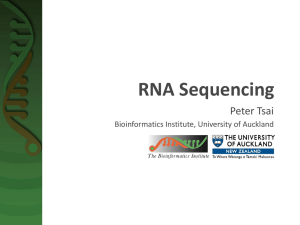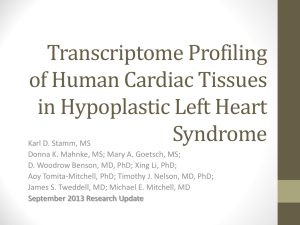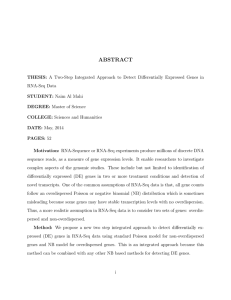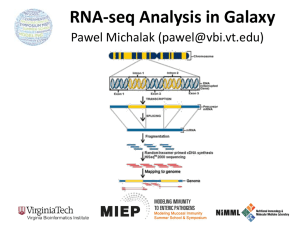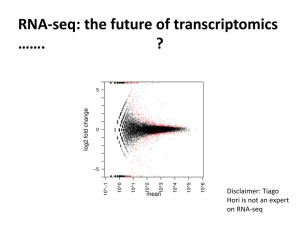Lecture 8 Understanding Transcription RNA-seq analysis Foundations of Computational Systems Biology
advertisement
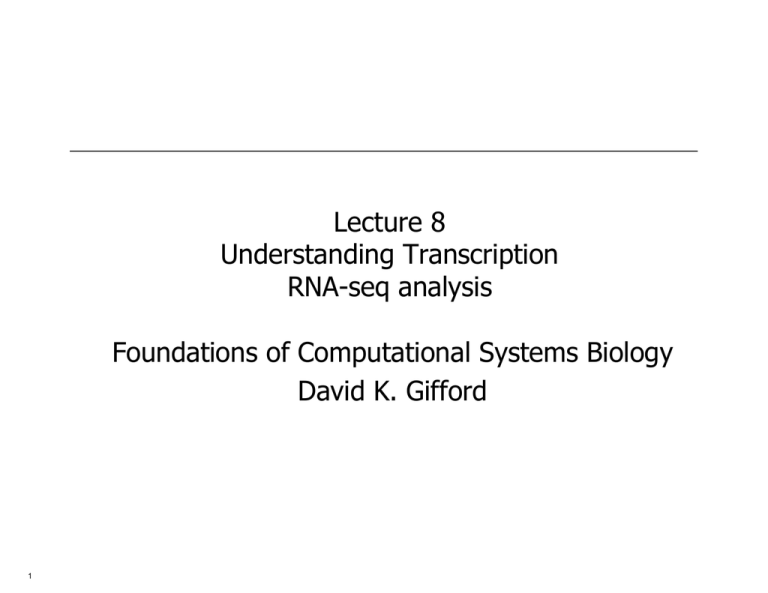
Lecture 8 Understanding Transcription RNA-seq analysis Foundations of Computational Systems Biology David K. Gifford 1 Lecture 8 – RNA-seq Analysis • RNA-seq principles – How can we characterize mRNA isoform expression using high-throughput sequencing? • Differential expression and PCA – What genes are differentially expressed, and how can we characterize expressed genes? • Single cell RNA-seq – What are the benefits and challenges of working with single cells for RNA-seq? 2 RNA-Seq characterizes RNA molecules export to cytoplasm nucleus A B A C C High-throughput sequencing of RNAs at various stages of processing mRNA splicing A B C pre-mRNA or ncRNA transcription A B C Gene in genome cytoplasm Courtesy of Cole Trapnell. Used with permission. Slide courtesy Cole Trapnel 3 Pervasive tissue-specific regulation of alternative mRNA isoforms. ET Wang et al. Nature 000, 1-7 (2008) doi:10.1038/ nature07509 4 Courtesy of Macmillan Publishers Limited. Used with permission. Source: Wang, Eric T., Rickard Sandberg, et al. "Alternative Isoform Regulation in Human Tissue Transcriptomes." Nature 456, no. 7221 (2008): 470-6. RNA-Seq: millions of short reads from fragmented mRNA Extract RNA from cells/tissue + splice junctions! Courtesy of Macmillan Publishers Limited. Used with permission. Source: Pepke, Shirley, Barbara Wold, et al. "Computation for ChIP-seq and RNA-seq Studies." Nature Methods 6 (2009): S22-32. Pepke et. al. Nature Methods 2009 5 Mapping RNA-seq reads to a reference genome reveals expression Sox2 6 RNA-seq reads map to exons and across exons Reads over exons Smug1 Junction reads (split between exons) 7 Two major approaches to RNA-seq analysis 1. Assemble reads into transcripts. Typical issues with coverage and correctness. 2. Map reads to reference genome and identify isoforms using constraints • Goal is to quantify isoforms and determine significance of differential expression • Common RNA-seq expression metrics are Reads per killobase per million reads (RPKM) or Fragments per killobase per million (FPKM) 8 Short sequencing reads, randomly sampled from a transcript exon 1 exon 2 exon 3 Aligned reads reveal isoform possibilities A B C identify candidate exons via genomic mapping A B A C B C Generate possible pairings of exons A B A C B C Align reads to possible junctions Courtesy of Cole Trapnell. Used with permission. Slide courtesy Cole Trapnell 9 We can use mapped reads to learn the isoform mixture ψ" D A C B Isoform T1 T2 T3 T4 Fraction ψ1" ψ2" ψ3" ψ4" E Courtesy of Cole Trapnell. Used with permission. Slide courtesy Cole Trapnell 10 Detecting alternative splicing from mRNA-Seq data Isoforms Inclusion reads Common reads Common reads Given a set of reads, estimate: = 11 Exclusion reads Distribution of isoforms P(Ri | T=Tj) – Excluded reads If a single ended read or read pair Ri is structurally incompatible with transcript Tj, then P(R = Ri | T = T j ) = 0 Ri Tj Intron in Tj Courtesy of Cole Trapnell. Used with permission. Slide courtesy Cole Trapnell 12 P(Ri | T=Tj) – Single end reads Cufflinks assumes that fragmentation is roughly uniform. The probability of observing a fragment starting at a specific position Si in a transcript of length lj is:"" 1 P(S = Si | T = Tj ) = lj starting position in transcript, Si Ri Tj Transcript length lj Courtesy of Cole Trapnell. Used with permission. Slide courtesy Cole Trapnell 13 P(Ri | T=Tj) – Paired end reads Assume our library fragments have a length distribution described by a probability density F.. Thus, the probability of observing a particular paired alignment to a transcript:"" F(l j (R j )) P(R = Ri | T = Tj ) = lj Implied fragment length lj(Ri) Ri Tj Courtesy of Cole Trapnell. Used with permission. Slide courtesy Cole Trapnell 14 Estimating Isoform Expression • Find expression abundances ψ1,…,ψn for a set of isoforms T1,…,Tn • Observations are the set of reads R1,…,Rm m n P(R | Ψ) = ∏ ∑ Ψ j P(R = Ri | T = Tj ) i=0 j=0 L(Ψ | R) ∝ P(R | Ψ)P(Ψ) Ψ = argmaxL(Ψ | R) Ψ • Can estimate mRNA expression of each isoform using total number of reads that map to a gene and ψ 15 Case study: myogenesis 1.0 Transcript categories, by coverage ● match contained intra−intron ● novel isoform repeat other 0.6 ● ● ● ● ● ● ● 0.4 ● ● ● ● ● ● ● ● ● ● ● ● ● ● ● ● ● ● ● ● ● ● ● ● ● ● ● ● ● ● ● ● ● ● ● ● ● ● ● ● ● ● ● ● ● ● ● ● ● ● ● ● ● ● ● ● ● ● ● ● ● ● ● ● ● ● ● ● ● ● ● ● ● ● ● ● ● ● ● ● ● ● ● ● ● ● ● ● ● ● 0.0 ● 1 10 100 1000 • Tracked 643 new isoforms of known genes across all points 10000 20000 50000 0.1 Tracked 8,134 transfrags across all time points, 5,845 complete matches to UCSC/ Ensembl/VEGA 0 Transcripts 0.01 • ● ● ● ● Nearly 70% of the reads in 14,241 matching transcripts ● ● ● • ● ● ● Cufflinks identified 116,839 distinct transcribed fragments (transfrags) ● ● ● ● ● ● • ● ● ● 0.2 Transcripts (%) 0.8 ● 0.01 0.1 1 10 100 1000 10000 Reads per bp Courtesy of Cole Trapnell. Used with permission. Slide courtesy Cole Trapnell 16 Case study: myogenesis 1.0 Transcript categories, by coverage ● match contained intra−intron ● novel isoform repeat other 0.6 ● ● ● ● ● ● ● ● ● ● ● ~25% of transcripts have light sequence coverage, and are fragments of full transcripts ● • Intronic reads, repeats, and other artifacts are numerous, but account for less than 5% of the assembled reads. ● ● 0.4 ● ● ● ● ● ● ● ● ● ● ● ● ● ● ● ● ● ● ● ● ● ● ● ● ● ● ● ● ● ● ● ● ● ● ● ● ● ● ● ● ● ● ● ● ● ● ● ● ● ● ● ● ● ● ● ● ● ● ● ● ● ● ● ● ● ● ● ● ● ● ● ● ● ● ● ● ● ● ● ● ● ● ● ● ● ● ● ● ● ● ● ● ● ● ● ● ● ● ● ● 0.0 ● 0.1 1 10 100 1000 10000 0.01 0.1 1 10 100 1000 10000 20000 50000 0.01 0 Transcripts • ● ● 0.2 Transcripts (%) 0.8 ● Reads per bp Courtesy of Cole Trapnell. Used with permission. Slide courtesy Cole Trapnell 17 Lecture 8 – RNA-seq Analysis • RNA-seq principles – How can we characterize mRNA isoform expression using high-throughput sequencing? • Differential expression and PCA – What genes are differentially expressed, and how can we characterize expressed genes? • Single cell RNA-seq – What are the benefits and challenges of working with single cells for RNA-seq? 18 19 20 21 22 23 Scaling RNA-seq data (DESeq) • • • • • i gene or isoform j sample (experiment) m number of samples Kij number of counts for isoform i in experiment j sj sampling depth for experiment j (scale factor) s j = median i 24 K ij ( m ∏ v=1 K iv ) 1 m Model for RNA-seq data (DESeq) • • • • • i gene or isoform p condition j sample (experiment) p(j) condition of sample j m number of samples Kij number of counts for isoform i in experiment j qip Average scaled expression for gene i condition p 1 K ij = ∑ q ip # of replicates j in replicates s j µ ij = q ip( j ) s j σ ij = µ ij + s j v p ( q ip( j )) 2 2 ~ NB , µ K ij ( ij σ ij ) 25 2 σ ij = µ ij + s j v p ( q ip( j )) 2 2 Orange Line – DESeq Dashed Orange – edgeR Purple - Poission Courtesy of the authors. License: CC-BY. Source: Anders, Simon, and Wolfgang Huber. "Differential Expression Analysis for Sequence Count Data." Genome Biology 11, no. 10 (2010): R106. 26 Significance of differential expression using test statistics • Hypothesis H0 (null) – Condition A and B identically express isoform i with random noise added • Hypothesis H1 – Condition A and B differentially express isoform • Degrees of freedom (dof) is the number of free parameters in H1 minus the number of free parameters in H0; in this case degrees of freedom is 4 – 2 = 2 (H1 has an extra mean and variance). • Likelihood ratio test defines a test statistic that follows the Chi Squared distribution P( K iA | H1)P( K iB | H1) T i = 2 log P ( K iA, K iB | H 0 ) P ( H 0 ) ≈ 1− ChiSquaredCDF (T i | dof ) 27 Courtesy of the authors. License: CC-BY. Source: Anders, Simon, and Wolfgang Huber. "Differential Expression Analysis for Sequence Count Data." Genome Biology 11, no. 10 (2010): R106. 28 Hypergeometric test for overlap significance N – total # of genes n1 - # of genes in set A n2 - # of genes in set B k - # of genes in both A and B ! n1 $! N − n1 $ & # &# " k %" n2 − k % P (k ) = ! N $ # & " n2 % 0.017 29 1000 20 30 3 P (x ≥ k) = min(n1,n2) 0.020 ∑ i=k P(i) 30 31 32 33 34 35 Lecture 8 – RNA-seq Analysis • RNA-seq principles – How can we characterize mRNA isoform expression using high-throughput sequencing? • Differential expression and PCA – What genes are differentially expressed, and how can we characterize expressed genes? • Single cell RNA-seq – What are the benefits and challenges of working with single cells for RNA-seq? 36 Courtesy of Fluidigm Corporation. Used with permission. 37 Single-cell RNA-Seq of LPS-stimulated bone-marrow-derived dendritic cells reveals extensive transcriptome heterogeneity. AK Shalek et al. Nature 000, 1-5 (2012) doi:10.1038/nature12172 38 Courtesy of Macmillan Publishers Limited. Used with permission. Source: Shalek, Alex K., Rahul Satija, et al. "Single-cell Transcriptomics Reveals Bimodality in Expression and Splicing in Immune Cells." Nature (2013). Analysis of co-variation in single-cell mRNA expression levels reveals distinct maturity states and an antiviral cell circuit. AK Shalek et al. Nature 000, 1-5 (2012) doi:10.1038/nature12172 39 Courtesy of Macmillan Publishers Limited. Used with permission. Source: Shalek, Alex K., Rahul Satija, et al. "Single-cell Transcriptomics Reveals Bimodality in Expression and Splicing in Immune Cells." Nature (2013). Analysis of co-variation in single-cell mRNA expression levels reveals distinct maturity states and an antiviral cell circuit. AK Shalek et al. Nature 000, 1-5 (2012) doi:10.1038/nature12172 40 Courtesy of Macmillan Publishers Limited. Used with permission. Source: Shalek, Alex K., Rahul Satija, et al. "Single-cell Transcriptomics Reveals Bimodality in Expression and Splicing in Immune Cells." Nature (2013). RNA-seq library complexity can help qualify cells for analysis Michal Grzadkowski © Michal Grzadkowski. All rights reserved. This content is excluded from our Creative Commons license. For more information, see http://ocw.mit.edu/help/faq-fair-use/. 41 RNA-seq library complexity can help qualify cells for analysis Michal Grzadkowski © Michal Grzadkowski. All rights reserved. This content is excluded from our Creative Commons license. For more information, see http://ocw.mit.edu/help/faq-fair-use/. 42 FIN 43 MIT OpenCourseWare http://ocw.mit.edu 7.91J / 20.490J / 20.390J / 7.36J / 6.802J / 6.874J / HST.506J Foundations of Computational and Systems Biology Spring 2014 For information about citing these materials or our Terms of Use, visit: http://ocw.mit.edu/terms.

